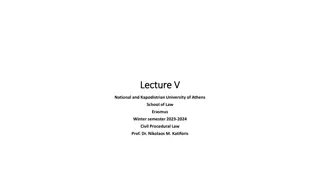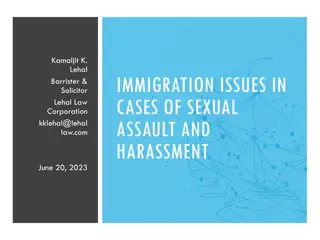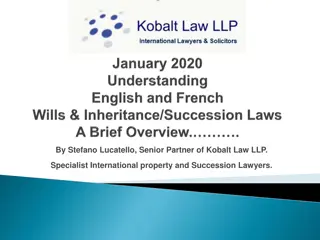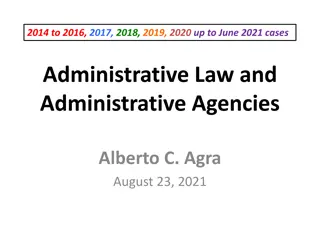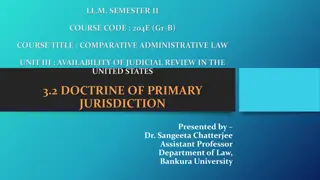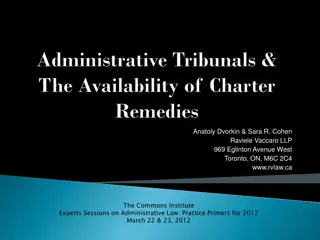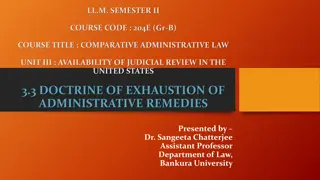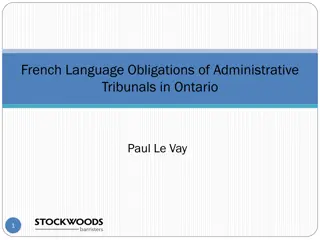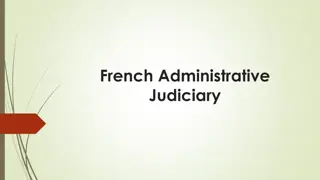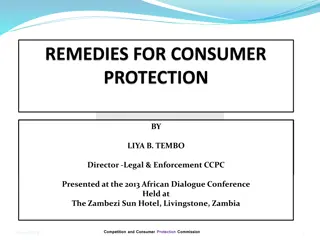Comparative Administrative Law: Remedies in French Administrative Law
The administrative justice system in France has evolved over the years, with various remedies available to challenge the lawfulness of administrative acts. The remedies are classified into formal and material categories based on historical developments and legal principles. Citizens can seek redress through actions such as annulment, reformation of administrative acts, or ruling on individual rights. This overview sheds light on the complexities of French administrative law and the remedies accessible to individuals.
Download Presentation

Please find below an Image/Link to download the presentation.
The content on the website is provided AS IS for your information and personal use only. It may not be sold, licensed, or shared on other websites without obtaining consent from the author. Download presentation by click this link. If you encounter any issues during the download, it is possible that the publisher has removed the file from their server.
E N D
Presentation Transcript
LL.M. SEMESTER II COURSE CODE : 204E (GR-B) COURSE TITLE : COMPARATIVE ADMINISTRATIVE LAW UNIT II : MERITS OF FRENCH ADMINISTRATIVE LAW, REMEDIES AVAILABLE UNDER FRENCH AND INDIAN ADMINISTRATIVE LAW 2.2 REMEDIES AVAILABLE UNDER FRENCH ADMINISTRATIVE LAW Presented by Dr. Sangeeta Chatterjee Assistant Professor Department of Law, Bankura University
INTRODUCTION The administrative justice in France oscillates between classicism and singularity. Multiple factors explain how administrative justice has come to occupya particularplace in French administrative law. Administrative justice has not only settled disputes between administration and private persons, but as well, built the French administrative law. One of the main tasks during 19th and 20th century consisted in strengthen the independence from the executive branch and theefficiency in order to satisfy the idea of good justice. Many reforms have been led since the 1990 s.
REMEDIES AVAILABLE BEFORE THE ADMINISTRATIVE COURT Citizens can challenge the lawfulness of acts adopted by the administration or assert rights against the latter through various remedies. The current classification of administrative courts comes history. It was forged by the courts and the systematization of jurisprudence. Two main classifications have been put forward. appeals available in the
FIRST CLASSIFICATION The first classification is formal. Developed in the nineteenth century, it is derived from the synthesis of the work of two state councilors, Leon Aucoc and Edouard Laferriere, who distinguished different types of litigation on the basis of the powers recognised to thecourtwhen considering the meritsof the claim. They identified four typesof litigation: 1. actions brought on grounds of ultra vires, in which the court may only annul thechallenged decision; 2. full litigation or full jurisdiction litigation, in which the judge can reform theadministrativeact; 3. litigation on interpretation orvalidity, through a referral fora preliminary ruling made the judicial court to the administrative court, in which the latter rules on the lawfulness of an act without settling the dispute between the parties; and 4. enforcement litigation, in which the court can order a citizen to repair the damagecaused to the publicdomain.
SECOND CLASSIFICATION The second classification is material. It results from the work of Leon Duguit who, in the late 19th century, established the distinction between different types of litigation on the basis of the nature of the issue put to the court. This criterion serves to identify Objective litigation, which concerns the lawfulness of an act, such as appeals brought on grounds of 1. ultra vires, 2. actions involving an assessment of lawfulness, or 3. certain othercases such as tax orelectoral disputes; and Subjective litigation, in which the court must rule on the existence of individual rights which the applicant derives from a single situation, such as contractual or liability disputes.
EXPLANATION These classifications, the primary value of which is educational, are not contradictory and may becombined. In practice the formal classification is the most important, however, because it helps to understand the different facets of the role played by the administrative court. Depending on the case concerned, the legal rules applicable to the appeal will not be the same. Within this classification, the appeal on grounds of ultra vires and full remedy actions hold a special place because they are predominant in the jurisdictional activityof the administrative courts. This distinction has evolved over time. To this must be added litigation concerning the implementation of the question prioritaire de constitutionnalite (priority preliminary ruling on constitutionality), to challenge the constitutionality of a law already in force.
CONCLUSION Comparative Law has a number of functions within the Conseil d Etat. Firstly, it serves to strengthen or reverse the legitimacy of established case law, particularly in the context of the integration of European norms. The finding of an isolated position in relation to other foreign courts regarding the interpretation of the law of the European Union may for example lead to a long overdue reversal of precedent. Conversely, an analysis of judicial decisions handed down by the European courts adopting a divergent position can strengthen the Conseil d Etat in its stance by wanting to mark stand apart on particular issues. Lastly, the comparative law argument can drive the creative force of the administrative courts and bring about changes in the state of the law on a sensitive social issue.
REFERENCE : 1) Hugo Flavierand Charles Froger, Administrative Justice in France: Between Singularity and Classicism, Brics Law Journal, Volume III, Issue 2, 2016, https://ssrn.com/abstract=2903077, visited on 06.06.2020.



